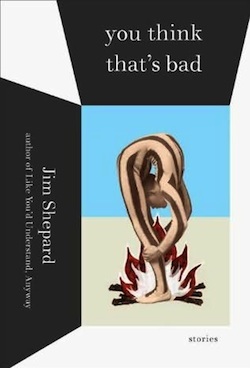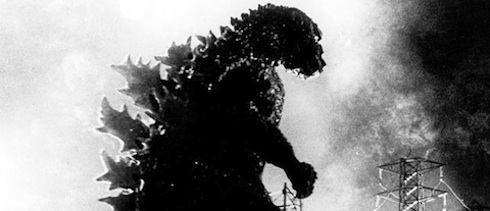Welcome to Genre in the Mainstream, a regular Tor.com blog series highlighting authors lurking in the shadows of literary fiction who just might have some fantasy, horror, or science fiction elements in their writing. We’re not saying these writers necessarily belong in those camps, but we do think they’re blurring some lines and that readers of the fantastical genres might enjoy them.
This week we take a look at the various monsters and humans occupying the stories of the celebrated writer Jim Shepard.
When I recently asked Shepard a modified version of the clichéd, “where do you get your ideas?” question, he responded, “I would be nowhere without my obsessions. Obsessions are good.” And one of Shepard’s obsessions seems to be monsters.
In the first Jim Shepard story I ever read (mentioned in a previous article here) the machinations and desires of famed amphibious monster, the Creature from the Black Lagoon are explored in a heartbreakingly matter-of-fact tale. Acting as a sort of prequel and companion piece to the famous film of the same name “The Creature from the Black Lagoon” begins 250 million years before the boat of humans shows up and starts cramping the Creature’s style. But when the people do get there, the reader is treated to all of the Creature’s inner thoughts, ranging from his enjoyment and regrets about his actions, to specific and excruciating gruesome detail of his kills. Among other things, the Creature comments on the dopey habit the humans have of always leaving around a handy rope, seemingly for his benefit.
 “Creature from the Black Lagoon” succeeds because despite the humor it doesn’t present the gimmick of doing a literary short story about the Creature in a gimmicky way. Instead the story takes you inside the psyche of a monster to a point that might be a little too close for comfort. Shepard employs this technique not just in his stories that deal with literal monsters, but in his “straight” literary stories, too. His most recent collection You Think That’s Bad (released March 2011) follows in the trend of his previous books by featuring a host of stories that star actual historical figures as the protagonists.
“Creature from the Black Lagoon” succeeds because despite the humor it doesn’t present the gimmick of doing a literary short story about the Creature in a gimmicky way. Instead the story takes you inside the psyche of a monster to a point that might be a little too close for comfort. Shepard employs this technique not just in his stories that deal with literal monsters, but in his “straight” literary stories, too. His most recent collection You Think That’s Bad (released March 2011) follows in the trend of his previous books by featuring a host of stories that star actual historical figures as the protagonists.
And while I’m sure he doesn’t intentionally evoke this response; I tend to think of all of these jaunts into the minds of historical characters like the set up for an episode of Quantum Leap. Only instead of Scott Bakula leaping the bodies of people in the past, it’s Jim Shepard! This is not to say that the voices of these various historical characters aren’t authentic, or that by writing about historical characters Shepard can somehow alter their prescribed fate; instead, by frequently occupying the bodies of real people, Shepard illuminates just how fantastical ALL fiction really is at its core. And the cast of characters, some real, and some imagined in the stories that make up You Think That’s Bad are all over the place. From doomed mountain climbers in “Poland is Watching,” to members of a secret Black Ops organization in “Minotaur,” to a man who dreams he is constantly swimming with prehistoric sea creatures in “In Cretaceous Seas” it becomes clear that Jim Shepard’s brand of literary fiction has more in common with the fantastic than it does with kitchen sink realism.
The story that stuck with me the most from this collection and that really spoke to Shepard’s monster love was “Gojira, King of the Monsters.” Telling the story of Japanese special effects master Eiichi Tsuburaya, this piece would be a treat for anyone mildly curious about how the first “Godzilla” film was initially created. From Tsuburaya’s obsessions with King Kong, to the plethora of technical problems faced by the production company, coupled by absurd time constraints put on the team by the studio, Shepard’s research is beyond rich. And yet, this story isn’t soley a fact farm about the making of Godzilla.
Instead, it is a story about a man creating a movie about the destruction of Japan at the hands of a giant rubber monster. Tsuburaya survived not only a fire bombing of Japan in WWII, but also a devastating earthquake that prevented him from being with his father at critical emotional juncture. And after experiencing what it was like for Japan to be ravaged by disaster, Tsuburaya made it possible for a miniature version of Tokyo to be laid to waste by a fictional monster of his own creation. In speaking about this story, Shepard is quick to point out that Tsuburaya’s decision to make a movie like Gojira after living through such catastrophes has the kind of “perversity” that really makes for a great story. When Shepard writes about the creation of the face of the monster, and the decisions revolving around what kind of expression Gojira should be wearing, the emotional angst of Tsuburaya can be felt and shared by any reader who has half a heart. It goes without saying that though this story was written prior to the recent events in Japan, there is a sort of echoing feeling one gets from reading this story right now. I imagine most readers will be haunted by the image giant lizard terrorizing not only the entire world, but one man’s life simultaneously.
All of Jim Shepard’s novels and short story collections have something in them for a reader of the fantastical genres. “The Creature from the Black Lagoon” is in the book Love and Hydrogen that pound for pound has more SFF-style stories in it than the newest book. However, the new book You Think That’s Bad, contains the wonderful story I just described and a bunch of other ones that will appeal to the same kind of sensibility. If you’re a human who enjoys exploring your inner monster, or a monster who is searching for your inner human, the writing of Jim Shepard is here to help.
Ryan Britt is a staff blogger for Tor.com and is guarded every night by a minature Gojira (Godzilla) toy which sits on his bookshelf and has been with him since the 3rd grade.










